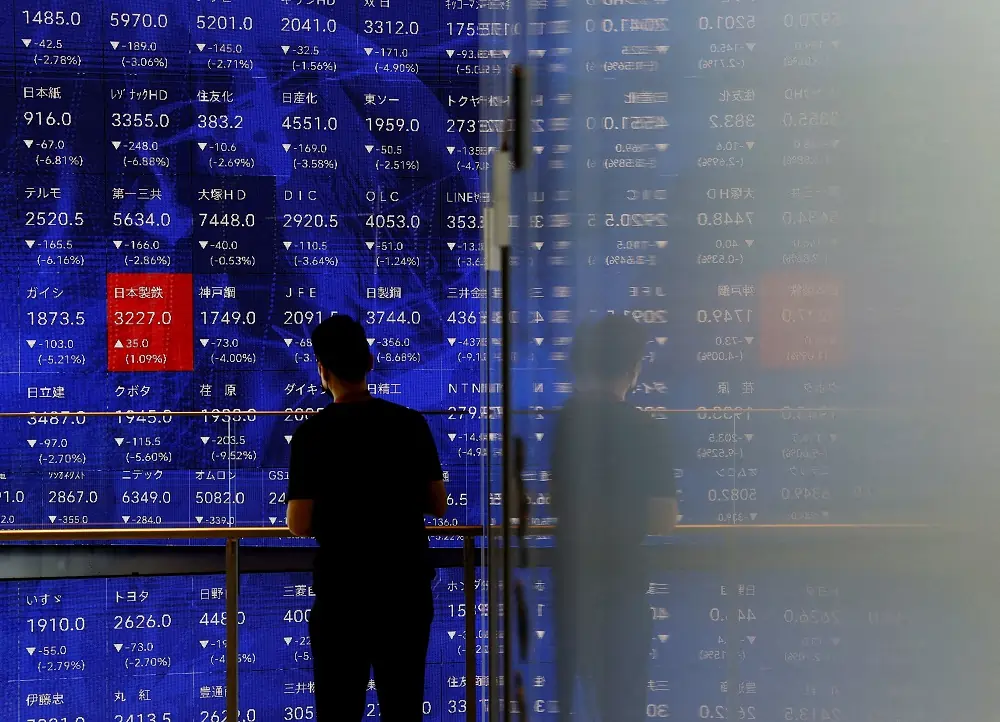
By Lawrence White
LONDON (Reuters) -U.S. stock futures faltered and the dollar was on the defensive on Wednesday, while bond prices rallied, as markets reacted to a U.S. presidential debate in which Vice President Kamala Harris put Republican Donald Trump on the defensive.
The presidential hopefuls battled over abortion, the economy, immigration and Trump’s legal woes at their combative first debate, leaving investors skittish ahead of U.S. inflation data that could influence the Federal Reserve’s policy moves next week.
U.S. Treasury and Euro zone government bond yields dipped, as Democrat candidate Harris’s robust showing fuelled expectations of a decline in interest rates, whereas investors expect higher spending that would boost rates if Trump wins.
Bond yields move inversely to prices.
Ten-year Treasury yields declined to a session trough of 3.609%, the lowest since June 2023, while Germany’s 10-year yield, the benchmark for the euro zone bloc, fell 2.5 basis points (bps) to 2.12%, a fresh one-month low.
Harris’ late entry in the presidential race after President Joe Biden’s withdrawal in July has tightened the race, and her strong debate performance continued a reversal of trades that were put in place on expectations of a second Trump presidency.
S&P 500 futures eased 0.36% and MSCI’s broadest index of Asia-Pacific shares outside Japan dropped 0.3%.
European shares were the bright spot, with the pan-European STOXX 600 index was edging up 0.07%, boosted by the oil and gas sectors on concerns that Hurricane Francine would disrupt output in the U.S.
Investors were focusing on fiscal policies and plans for the economy from the candidates but the presidential debate was light on details, although betting markets swung in Harris’ favour after the event. In a boost to the Harris campaign, pop megastar Taylor Swift said she would back Harris in the Nov. 5 election.
“With the dust settling on the Trump vs Harris presidential debate, it’s clear that the market saw this debate going to Kamala Harris,” said Chris Weston, head of research at Pepperstone.
“This debate was never going to be an exercise in digging deep into the weeds and into the granularity of the respective policies, and we’re certainly not significantly wiser on that front.”
The dollar index, which measures the U.S. currency against six peers, was down 0.3% at 101.39.
“You’d expect if he (Trump) was doing better, that you’d see a strong dollar coming out of this. So I suppose that’s the way the market is looking at it. It’s a slight lean towards Harris,” said Rob Carnell, ING’s regional head of research for Asia-Pacific.
The yen strengthened more than 1% to 140.71 per dollar, the highest since late December, boosted also by comments from Bank of Japan board member Junko Nakagawa.
Nakagawa reiterated in a speech that the central bank would continue to raise interest rates if the economy and inflation move in line with its forecasts.
Shares of U.S. cryptocurrency and blockchain-related companies declined in premarket trading, tracking losses in bitcoin which fell 2%. Speaking at the Bitcoin 2024 convention in Nashville in July, Trump had positioned himself as the pro-cryptocurrency candidate.
INFLATION WATCH
Investors are now focusing on the U.S. Labor Department’s consumer price index report later on Wednesday for policy clues, although the Federal Reserve has made it clear employment has taken on a greater focus than inflation.
The headline CPI is expected to have risen 0.2% on a month-on-month basis in August, according to a Reuters poll, unchanged from the previous month.
While the Fed is widely expected to cut interest rates next week, the size of the rate cut is still up for debate, especially after a mixed labour report on Friday failed to provide clarity on which way the central bank could go.
“What we needed to see to spur the Fed into greater action would be much more obvious evidence of slowdown/recession, and in particular in the labour market. And I don’t think we saw that in the last payrolls report,” said ING’s Carnell.
Markets are currently pricing in a 65% chance of the U.S. central bank cutting rates by 25 basis points, while a 35% chance is ascribed for a 50 bps cut when the Fed delivers its decision on Sept. 18, CME FedWatch tool showed.
In commodities, oil prices gained after dropping over 3% in the previous session, as a drop in U.S. crude inventories and concern about Hurricane Francine disrupting U.S. output countered concerns about weak global demand.[O/R]
Brent crude futures rose 1.47% to $70.21 a barrel, and U.S. West Texas Intermediate (WTI) crude rose 1.73% to $66.88.
(Reporting by Ankur Banerjee and Lawrence White; Editing by Shri Navaratnam, Jacqueline Wong and Kim Coghill)


